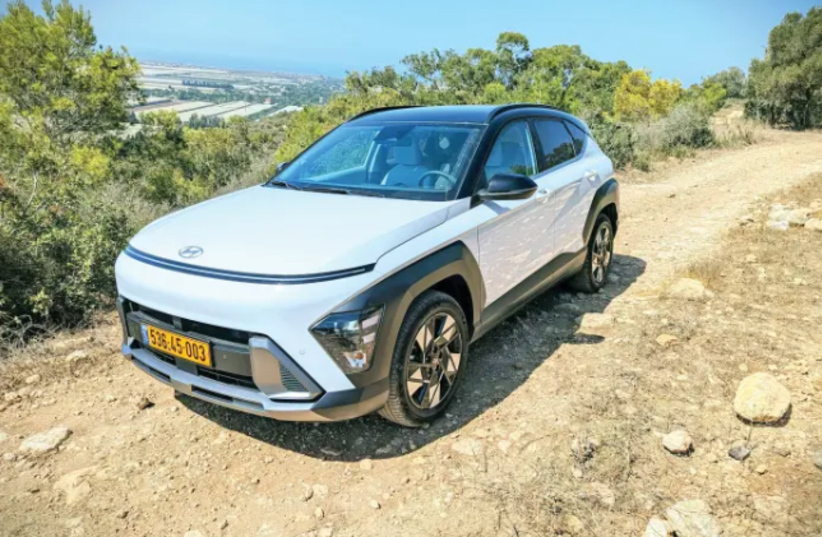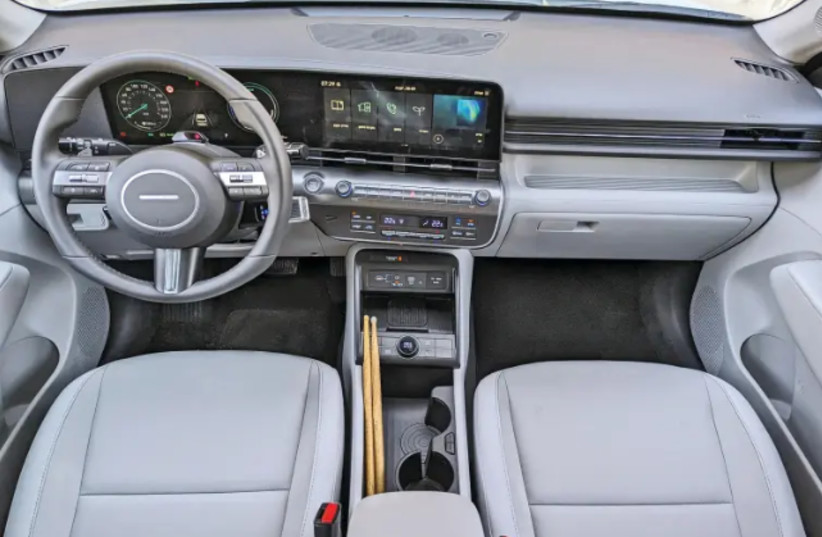There is a difference between the first encounter with a completely new model in the market, let's say one that is not a continuation of an outgoing generation or a replacement, and the evaluation of a new generation of an existing model. We will always approach the new generation with the insights and impressions from the outgoing generation, and beyond the question of what the car should do and how it does it, we also ask ourselves what is allowed for the incoming generation compared to the one that has been replaced – where is the improvement, the good news, the change?
That is exactly our starting point for testing the new Hyundai purchase. Only this time it's completely different. Because the new purchase is a combination of both, a replacement for the outgoing generation and also a model positioned elsewhere in Hyundai's lineup, one that no longer creates the strange overlap that was present in the previous generation and caused quite a debate about its place in the showroom facing the Bayonne. And it tries not to miss any customer: today we are testing the hybrid version (from 162,000 shekels), there is also a gasoline one (from 145,000 shekels for the 1,000cc turbo) and in a few months, the electric versions will arrive.
Design: For the previous generation, there was a kind of sporty and playful approach, this time it aligns with Hyundai's new and clean language, with a kind of sleek front that momentarily tricks you into thinking it's an electric car, a version that indeed exists and will arrive later.
Passenger cabin: The passenger cabin environment also undergoes a very significant change. Gone are the simple and rough plastic panels, no longer giving the feeling that the cabin is "closing in" on its occupants, but rather a clean, high-tech appearance, where the integration of light tones definitely improves the situation. In terms of the evaluated finish level, the driver and passenger seats are electrically adjustable, with a good driving position, and the outward visibility, except for a slightly thick front pillar, is not limiting, but requires adaptation.
With the transfer of the interior design from the Ioniq 5 and Ioniq 6, good human engineering is also obtained. On one hand, there is a large touch screen (12.3 inches), clear, easy to use, readable in all lighting conditions, and with built-in Hebrew language, and on the other hand, there are physical rings, buttons, and switches for one-touch operation of important functions.
So it looks less "advanced." Between us, I prefer this over an "advanced" cabin where the driver has to press multiple screens to change the climate control mode while physically advancing into traffic. The instrument cluster, also 12.3 inches, presents the necessary basic information. As usual with Hyundai, there aren't many games or utilization of the screen's potential.
There is a good amount of storage compartments, including an open shelf in front of the passenger where you can place your mobile phone and other small items, as the central console is known to be the territory of the driver. But the truth is, here is spacious enough to create order from the chaos.
The increase in dimensions in the current generation, which added 15 cm in overall length, is reflected in an extended wheelbase of 6 cm. In terms of interior space, it is close to the Tucson (2.68 meters). The result is a very spacious rear seat area for the knees, feet, and head. The small bulge on the floor will not hinder a third child from sitting here, but the overall width of the seat might. There is also a narrow space between the lower part of the entrance and the seat, which makes entry a bit difficult. Fortunately, there are two air conditioning vents and two USB ports here.
Charging compartment: The same increase in dimensions also brings a larger charging compartment than before. 466 liters compared to 374 liters in the previous hybrid version. This is a significant difference, one that can accommodate a device for family use without compromise.
By the way, in terms of compromises, when you lift the floor of the charging compartment, you will find a puncture repair kit and not a spare tire. The good news is that there is space for one, so those who are wise can purchase and place one there. The rest of the compartment is standard, with a convenient charging port, not too high, four hanging hooks, anchor rings, and we would also be happy with a 12V socket.
Equipment: In terms of the tested "Sophrim" finishing level, it is actually equipped with the most comprehensive equipment list below the "Sporty" N LINE version. It includes two-tone paint, ambient lighting, wireless charging, electric charging port opening, lower back support in the driver's seat, control over gears or regeneration mode behind the steering wheel.
The advanced safety equipment list is also extensive: lane-keeping assist, automatic braking, driver alertness detection (a bit too strict, but maybe that's just me), off-road vehicle detection with lane change prevention and door opening alert, adaptive cruise control, reminder to prevent child forgetting, and speed limit detection with warning. The last system needs some calibration, though, as it is not really successful in what it is supposed to do and occasionally displays quite random speeds, and it needs to be deactivated at the beginning of each journey to get rid of the annoyance and beeping.
Performance: The hybrid version of the vehicle makes use of the power unit inherited from the previous generation. It has a 1.6-liter gasoline engine with an additional electric unit that provides 139 horsepower (141 in the previous generation) and 27 km per liter. The propulsion is front-wheel drive through a dual-clutch transmission.
This is not a car you buy to be the first at a traffic light, but rather the last at the gas station. That's how the whole business is conducted. Officially, it goes from 0 to 100 km/h in 11.2 seconds, a figure that sounds like a relic from the era of smoking carburetors with 7.7 seconds for popular electric cars. In practice, the acceleration rate is quite reasonable, the electric booster provides the initial thrust, and the gasoline engine immediately follows.
Fuel consumption: With conscious and moderate driving, we were able to achieve a figure not far from the official one - 19.9 km per liter, in real-world conditions, compared to 21.3 km per liter. Calculating the total travel distance with the adopted segments, the consumption stood at 16.9 km per liter. "Playing" with the four modes of regeneration of the electric motor (including driving in one pedal mode, a rare feature in hybrids) significantly improved the situation.
Comfort and behavior: The previous model did not excel in terms of ride comfort in the gasoline version, the hybrid version improved that, and the present one raises the score even further. It copes well with urban obstacles, and minor vibrations that penetrate can be attributed to the low tire profile and 18-inch rims. With increased speed, the handling improves, and it is definitely comfortable on the highway even when not perfect. Noise isolation is successful, and again, except for tire noise due to their width, it receives a good score in this aspect as well.
As with the performance aspect, in road behavior, one must understand that the hybrid buyer will not purchase it for the pleasure of driving, just as none of its competitors would. But in doing what it is supposed to do - taking from point A to point B - it performs well. The steering is light but precise, there is a lot of grip, you can also drive it a bit faster without it losing composure, and even if you push it here and there, it won't get you into trouble.
The bottom line: The new Hyundai Kona is exactly what a model that replaces a generation should do and what is expected from a model entering a new segment. From the first aspect, it simply surpasses clause after clause in what was not good in the previous generation and does it significantly better - space, cargo area, material quality, multimedia, noise isolation, comfort. In terms of its entry as a new model, it manages to create a differentiation at the product level from the competition (size, quality, performance, savings) and in fact, except for the dimensions, it does not fall behind in performance compared to the significantly more expensive Tucson.
The hybrid Kona starts at 162,000 shekels for its entry level, 164,000 shekels for the mid-range version and up to 170,000 shekels for the tested one. This means that even in the more expensive version, it is cheaper than the entry level versions of its two main competitors - the Toyota Corolla Cross Hybrid and the Renault Arkana Hybrid. In fact, in the base version, which is still well-equipped, it is very close in price to the two popular sedan models, the Toyota Corolla and the Hyundai Elantra, and will also attract customers from them.
Is the new Kona a successful car? Definitely. For those who already found the sporty/Rav4/Austral and the rest of the gang to be too big and expensive, it is a solution that fits exactly in that segment. True, it is still a compact crossover, and 170,000 shekels is a lot of money in any normal measure for a compact crossover. It is not certain that you necessarily need the most expensive and well-equipped one, but still, amidst the trading of exchange rates of all the new cars, at least the product is worthy.
ID / Hyundai Ioniq Hybrid
Engine: gasoline, hybrid, 1,600 cc. Power 139 horsepower, torque 27 kgm.
Transmission: dual clutch, 7 gears, front-wheel drive.
Performance (manufacturer): 11.2 seconds from 0 to 100 km/h, top speed of 165 km/h, 21.3 km per liter combined.
Safety: Not tested in European crash test. Full active safety package.
Air pollution: Group 3 out of 15.
Warranty: 5 years or 100,000 km,
7 years or 150,000 km for the hybrid system.
Price: 170,000 shekels (test), 162,000 shekels (base).
Liked: Comfort, human engineering, spaciousness, cargo space, fuel efficiency, hybrid system.
Disliked: Rear door key, test version price.
Rating: 9 out of 10.

